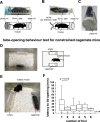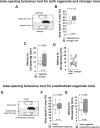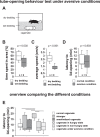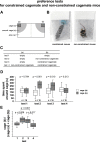Helping-Like Behaviour in Mice Towards Conspecifics Constrained Inside Tubes
- PMID: 30967573
- PMCID: PMC6456590
- DOI: 10.1038/s41598-019-42290-y
Helping-Like Behaviour in Mice Towards Conspecifics Constrained Inside Tubes
Abstract
Prosocial behaviour, including helping behaviour, benefits others. Recently, helping-like behaviour has been observed in rats, but whether it is oriented towards rescue, social contact with others, or other goals remains unclear. Therefore, we investigated whether helping-like behaviour could be observed in mice similar to that in rats. Because mice are social animals widely used in neuroscience, the discovery of helping-like behaviour in mice would be valuable in clarifying the psychological and biological mechanisms underlying pro-sociability. We constrained mice inside tubes. Subject mice were allowed to move freely in cages with tubes containing constrained conspecifics. The subject mice released both cagemates and stranger mice but did not engage in opening empty tubes. Furthermore, the same behaviour was observed under aversive conditions and with anesthetised conspecifics. Interestingly, hungry mice opened the tubes containing food before engaging in tube-opening behaviour to free constrained conspecifics. Mice showed equal preferences for constrained and freely moving conspecifics. We demonstrated for the first time that mice show tube-opening behaviour. Furthermore, we partly clarified the purpose and motivation of this behaviour. An effective mouse model for helping-like behaviour would facilitate research on the mechanisms underlying prosocial behaviour.
Conflict of interest statement
The authors declare no competing interests.
Figures





Similar articles
-
Rescue-like Behaviour in Mice is Mediated by Their Interest in the Restraint Tool.Sci Rep. 2019 Aug 2;9(1):10648. doi: 10.1038/s41598-019-46128-5. Sci Rep. 2019. PMID: 31375693 Free PMC article.
-
No preference for prosocial helping behavior in rats with concurrent social interaction opportunities.Learn Behav. 2021 Dec;49(4):397-404. doi: 10.3758/s13420-021-00471-8. Epub 2021 Apr 7. Learn Behav. 2021. PMID: 33829419
-
Cortical regulation of helping behaviour towards others in pain.Nature. 2024 Feb;626(7997):136-144. doi: 10.1038/s41586-023-06973-x. Epub 2024 Jan 24. Nature. 2024. PMID: 38267578 Free PMC article.
-
The evolutionary roots of prosociality: the case of instrumental helping.Curr Opin Psychol. 2018 Apr;20:82-86. doi: 10.1016/j.copsyc.2017.08.019. Epub 2017 Aug 12. Curr Opin Psychol. 2018. PMID: 28850865 Review.
-
Empathy as a driver of prosocial behaviour: highly conserved neurobehavioural mechanisms across species.Philos Trans R Soc Lond B Biol Sci. 2016 Jan 19;371(1686):20150077. doi: 10.1098/rstb.2015.0077. Philos Trans R Soc Lond B Biol Sci. 2016. PMID: 26644596 Free PMC article. Review.
Cited by
-
Conformity-like behaviour in mice observing the freezing of other mice: a model of empathy.BMC Neurosci. 2020 May 1;21(1):19. doi: 10.1186/s12868-020-00566-4. BMC Neurosci. 2020. PMID: 32357830 Free PMC article.
-
Inducing Partner Preference in Mice by Chemogenetic Stimulation of CA2 Hippocampal Subfield.Front Mol Neurosci. 2020 Apr 23;13:61. doi: 10.3389/fnmol.2020.00061. eCollection 2020. Front Mol Neurosci. 2020. PMID: 32390799 Free PMC article.
-
Small workers are more persistent when providing and requiring help in a monomorphic ant.Sci Rep. 2023 Dec 7;13(1):21580. doi: 10.1038/s41598-023-49012-5. Sci Rep. 2023. PMID: 38062073 Free PMC article.
-
Body language signals for rodent social communication.Curr Opin Neurobiol. 2021 Jun;68:91-106. doi: 10.1016/j.conb.2021.01.008. Epub 2021 Feb 11. Curr Opin Neurobiol. 2021. PMID: 33582455 Free PMC article. Review.
-
Rescue-like Behaviour in Mice is Mediated by Their Interest in the Restraint Tool.Sci Rep. 2019 Aug 2;9(1):10648. doi: 10.1038/s41598-019-46128-5. Sci Rep. 2019. PMID: 31375693 Free PMC article.
References
-
- Olmstead, M. C. & Kuhlmeier, V. A. Prosociality in Comparative Cognition. 369–365 (Cambridge University Press, 2015).
-
- Dugatkin LA. Animal cooperation among unrelated individuals. Naturwissenschaften. 2002;89:533–541. - PubMed
-
- Krause, J. & Ruxton, G. D. Living in groups. (Oxford University Press, 2002).
Publication types
MeSH terms
LinkOut - more resources
Full Text Sources

